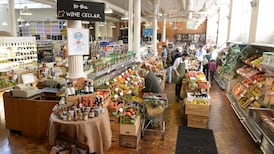The world’s most expensive hamburger will be served in a London restaurant today, made entirely from synthetic meat at a cost of €250,000.
A live stream of the burger being eaten can be watched at culturedbeef.net. The "in vitro" burger was developed Prof Mark Post at Maastricht University in the Netherlands using stem cells from a slaughtered cow.
It will be made up of 3,000 strips of artificial beef, each the size of a grain of rice, grown from bovine cells in a laboratory.
The cow stem cells develop into a strip of muscle cells after being cultured in a synthetic broth containing vital nutrients.
The resulting strips begin to contract like real muscle, and are attached to Velcro and repeatedly stretched to keep them supple.
The 5oz burger will be served to an invited audience at an exclusive west London venue, the name of which has not yet been released.
Prof Post expects the burger to taste “reasonably good” though it might need a bit of salt and pepper. He said it is possible to add fatty tissue to the fibres to make them more palatable, as well as other nutrients to make the artificial meat as nutritious as the real thing, and possibly healthier.
Flavour notwithstanding, the culinary demonstration is the culmination of years of work by Prof Post, who is a medical physiologist, with the research being funded by a wealthy anonymous backer.
Cost concerns
Those who fear the imminent onslaught of "frankenfood" need not worry too much, according to Prof Martin Clynes, the director of the National Institute for Cellular Biotechnology at Dublin City University.
He says that it would not be commercially viable to produce synthetic meat on a mass scale.
“The cost of the technology is an obstacle. While it’s a huge technical achievement, I’d have a question mark about doing this economically.”
Prof Clynes also said the product may not be entirely appetising to vegetarians.
“A cow is still sacrificed to get the stem cells. So I think there might be a sliding scale of vegetarians who will eat the meat. It might not be universally accepted by them.”
He says stem cells taken from one animal could, in principle, be used to make a lot more meat than could be butchered from a single beef carcass.
This view is echoed by Prof Mohamed Al-Rubeai, the director of the Cell Culture Engineering Research Centre at University College Dublin. “In theory you could make an unlimited amount of meat,” he says. “You could produce thousands or millions more meat.”
Professor of cellular therapy at NUI Galway Frank Barry said cells grown in a laboratory are susceptible to contamination by bacteria, fungi and moulds.
“This is a big issue and many procedures require the use of large doses of antibiotics, which is very undesirable in terms of human food,” he says.
The current technology would be seriously challenged to produce more than a few burgers, he says, adding he could not imagine anything that has been in a plastic tissue culture flask for weeks would taste good. “This technology will never replace conventional farming, which has been developed for thousands of years to a model of very tight efficiency. As for providing food for developing countries, I think that will be impossible,” he says.
The Food Safety Authority of Ireland said any artificial meat would need to pass a number of safety tests before going on sale. Chief specialist in food technology Dr Pat O’Mahony said any novel food, such as synthetic meat, would have to undergo stringent safety tests before being placed on the market.
"A novel food regulation has been in place since 1997. As artificial meat wasn't on the market before then, it would have to go through the novel food tests," he says. "On top of the very long development process to make artificial meat commercially viable, it would also have a long regulatory process."
Eating insects
He says the public will be eating insects as a source of protein instead of meat in years to come.
“The EU has been sounding the horn about the use of insects as a source of protein and they’re not plucking this out of the air. I think we will be eating them long before we see synthetic meat on the market,” he says.
People for the Ethical Treatment of Animals (Peta), which is currently offering a $1 million prize to the first person or organisation to produce commercially viable in vitro meat from chicken cells, said cultured meat could be ethically acceptable if it meant less slaughtering.
While it welcomed the advancements made by Prof Post, the animal rights group said: “Peta’s primary interest is in replacing chicken factories, transport, and slaughter because more than 1 million chickens are eaten every hour in the US alone.”
Despite the obstacles, Prof Post is confident that laboratory-grown meat is in our future, and that it will help to save the environment and prevent a food crisis.
A study by Oxford University in 2011 found that producing cultured meat would result in between 78 and 95 per cent fewer greenhouse gases.
The Food and Agriculture Organisation predicts that the world will be eating twice as much meat in 2050 as now due to increased demand from a growing middle class in China and other developing nations.
Prof Post is not the only one on the engineered meat case. In the US, a start-up called Modern Meadow is taking 3D printing to a whole new level, seeking to mass produce bioengineered meat that comes out of a 3D printer.
Hungarian-born Gabor Forgacs, of the University of Missouri, is a specialist in tissue engineering, and has been working to create replacement tissue and organs for humans.
Realising the same technology could be used to engineer meat for human consumption, he set up Modern Meadow with his son Andras. The two hope to develop cultured leather and meat products which require no animal slaughter and much lower inputs of land, water, energy and chemicals.
Whether a hamburger made from artificial meat fibres and synthetic fat can ever match the real thing, the invited audience in London will find out today.










